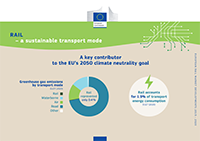The eighth Rail Market Monitoring Report (RMMS) on the state of the EU rail market shows positive developments in 2019, before a significant change in traffic volumes in 2020 due to COVID-19. In the pre-pandemic period, rail traffic rose consistently, with volumes increasing by a yearly average of 3% in both passenger and freight transport up until 2019. Throughout 2020, restrictions to mobility aimed at containing the pandemic resulted in a decrease in traffic volumes that was particularly noticeable in passenger transport (-46% in 2020 compared to 2019). Rail freight traffic was less severely affected, with a 8% reduction in volume over the same period. Data for 2021 show promising recovery in both passenger and freight transport volumes.
Between 2015 and 2020, the market share of competitors, i.e. that of the alternative operators to national incumbents, increased in most EU countries (albeit with a temporary decrease in 2020 due to the pandemic). The market opening for cross-border services in 2010 and domestic services in 2020, driven by the EU’s four railway packages, were key catalysts in this process. In 2020, new rail freight operators were competing with national incumbents in all but two countries, and in half of them the market share of competitors was more than 40%. Only half of EU Member States have competitors operating in the commercial passenger market, and in 2020 more than 60% of train kilometers were operated under public service contracts.
The report shows that at the end of 2020, about 910,000 people were employed in the European railway sector. This workforce remained predominantly male; on average only 22% of employees were women. Over 40% of the workforce was aged 50 or over in both railway undertakings and Infrastructure Managers; this ageing of the workforce remains concerning.
On infrastructure, the report shows that the total length of the EU rail network in 2020 was around 201,000 kilometres. About 57% of the network was electrified. The high-speed network stretched to over 11,500 line kilometres, an increase of 14.5% since 2015. The total spending on infrastructure rose from EUR 39.1 billion in 2015 to EUR 41.8 billion in 2020. In 2020, 25% of the spending was on maintenance, 27% on renewals, 28% on upgrades and 20% on investment in new infrastructure.
Key documents
The report gives a high-level overview of the main developments; the full analysis is presented in the accompanying Commission Staff Working Document.
Data and figures are also available in Excel format below. Previous editions.

Details
- Publication date
- 27 September 2023
- Author
- Directorate-General for Mobility and Transport
